Accounting for Business: Financial Analysis and Decision Making
VerifiedAdded on 2022/11/26
|6
|1264
|465
Homework Assignment
AI Summary
This assignment solution delves into key financial concepts, including ratio analysis, revenue recognition, and short-term loan decisions. Part A focuses on evaluating a company's liquidity and efficiency using ratios like current, quick, accounts receivable turnover, and inventory turnover. The analysis compares performance over two years and against industry averages, highlighting the impact of efficiency measures on working capital. Part B addresses the application of AASB 118 to determine revenue recognition for various financial items, distinguishing between revenue and other income sources. Part C provides a comparative analysis of two companies (XYZ and ABC) to determine the most suitable candidate for a short-term loan and a higher company valuation, considering liquidity, capital structure, and existing liabilities. The solution is supported by references to relevant accounting and finance literature.
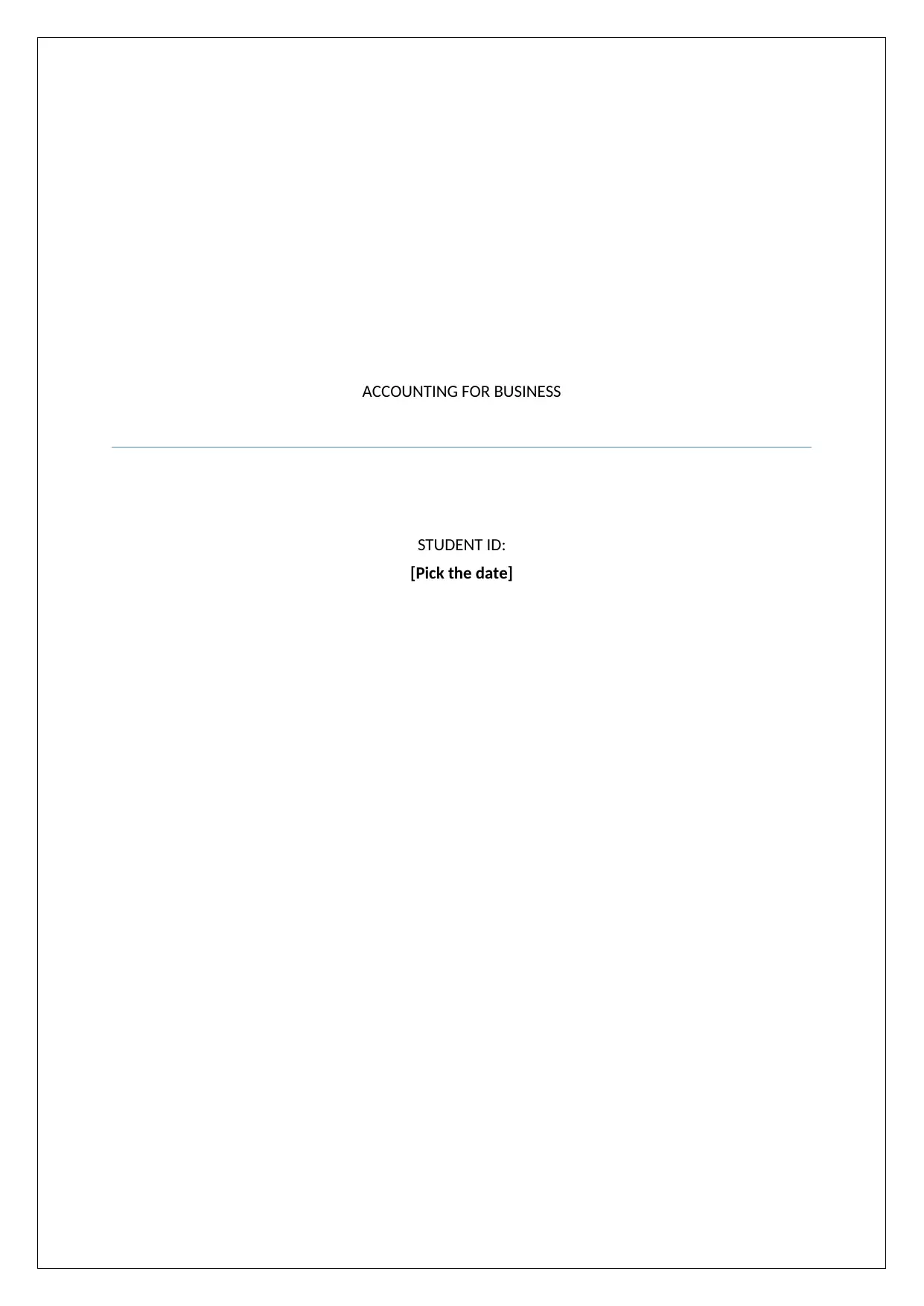
ACCOUNTING FOR BUSINESS
STUDENT ID:
[Pick the date]
STUDENT ID:
[Pick the date]
Paraphrase This Document
Need a fresh take? Get an instant paraphrase of this document with our AI Paraphraser
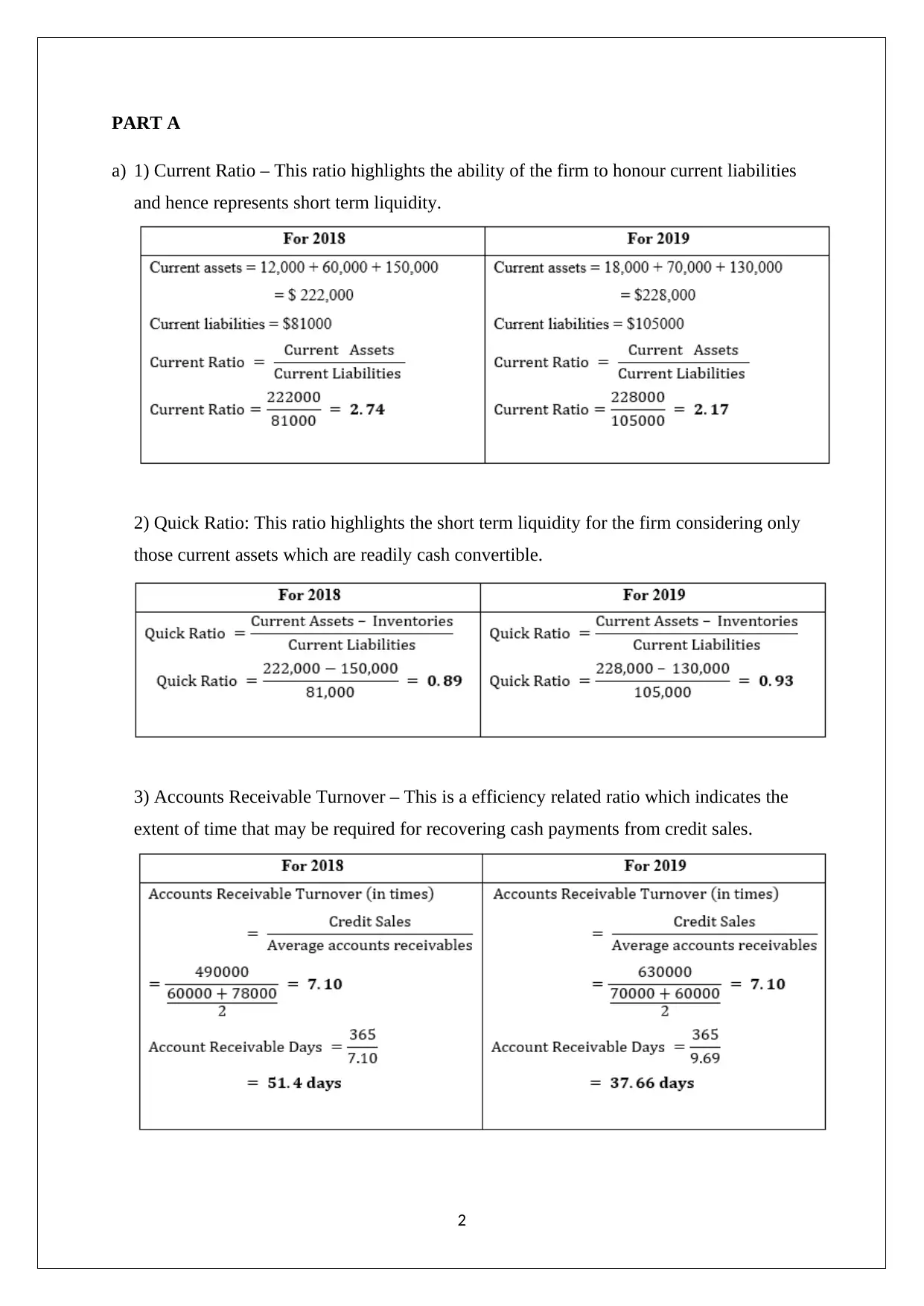
PART A
a) 1) Current Ratio – This ratio highlights the ability of the firm to honour current liabilities
and hence represents short term liquidity.
2) Quick Ratio: This ratio highlights the short term liquidity for the firm considering only
those current assets which are readily cash convertible.
3) Accounts Receivable Turnover – This is a efficiency related ratio which indicates the
extent of time that may be required for recovering cash payments from credit sales.
2
a) 1) Current Ratio – This ratio highlights the ability of the firm to honour current liabilities
and hence represents short term liquidity.
2) Quick Ratio: This ratio highlights the short term liquidity for the firm considering only
those current assets which are readily cash convertible.
3) Accounts Receivable Turnover – This is a efficiency related ratio which indicates the
extent of time that may be required for recovering cash payments from credit sales.
2
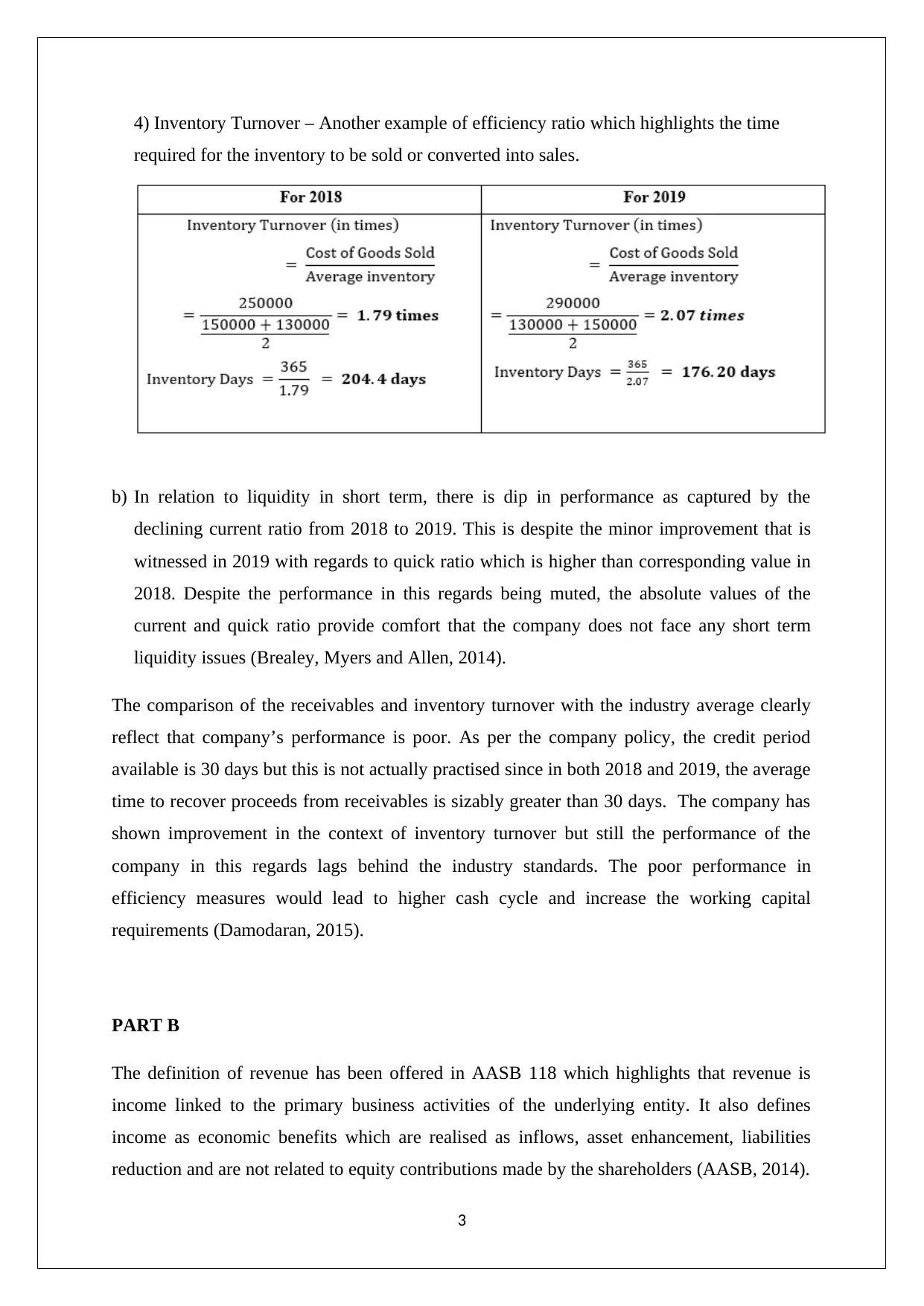
4) Inventory Turnover – Another example of efficiency ratio which highlights the time
required for the inventory to be sold or converted into sales.
b) In relation to liquidity in short term, there is dip in performance as captured by the
declining current ratio from 2018 to 2019. This is despite the minor improvement that is
witnessed in 2019 with regards to quick ratio which is higher than corresponding value in
2018. Despite the performance in this regards being muted, the absolute values of the
current and quick ratio provide comfort that the company does not face any short term
liquidity issues (Brealey, Myers and Allen, 2014).
The comparison of the receivables and inventory turnover with the industry average clearly
reflect that company’s performance is poor. As per the company policy, the credit period
available is 30 days but this is not actually practised since in both 2018 and 2019, the average
time to recover proceeds from receivables is sizably greater than 30 days. The company has
shown improvement in the context of inventory turnover but still the performance of the
company in this regards lags behind the industry standards. The poor performance in
efficiency measures would lead to higher cash cycle and increase the working capital
requirements (Damodaran, 2015).
PART B
The definition of revenue has been offered in AASB 118 which highlights that revenue is
income linked to the primary business activities of the underlying entity. It also defines
income as economic benefits which are realised as inflows, asset enhancement, liabilities
reduction and are not related to equity contributions made by the shareholders (AASB, 2014).
3
required for the inventory to be sold or converted into sales.
b) In relation to liquidity in short term, there is dip in performance as captured by the
declining current ratio from 2018 to 2019. This is despite the minor improvement that is
witnessed in 2019 with regards to quick ratio which is higher than corresponding value in
2018. Despite the performance in this regards being muted, the absolute values of the
current and quick ratio provide comfort that the company does not face any short term
liquidity issues (Brealey, Myers and Allen, 2014).
The comparison of the receivables and inventory turnover with the industry average clearly
reflect that company’s performance is poor. As per the company policy, the credit period
available is 30 days but this is not actually practised since in both 2018 and 2019, the average
time to recover proceeds from receivables is sizably greater than 30 days. The company has
shown improvement in the context of inventory turnover but still the performance of the
company in this regards lags behind the industry standards. The poor performance in
efficiency measures would lead to higher cash cycle and increase the working capital
requirements (Damodaran, 2015).
PART B
The definition of revenue has been offered in AASB 118 which highlights that revenue is
income linked to the primary business activities of the underlying entity. It also defines
income as economic benefits which are realised as inflows, asset enhancement, liabilities
reduction and are not related to equity contributions made by the shareholders (AASB, 2014).
3
⊘ This is a preview!⊘
Do you want full access?
Subscribe today to unlock all pages.

Trusted by 1+ million students worldwide
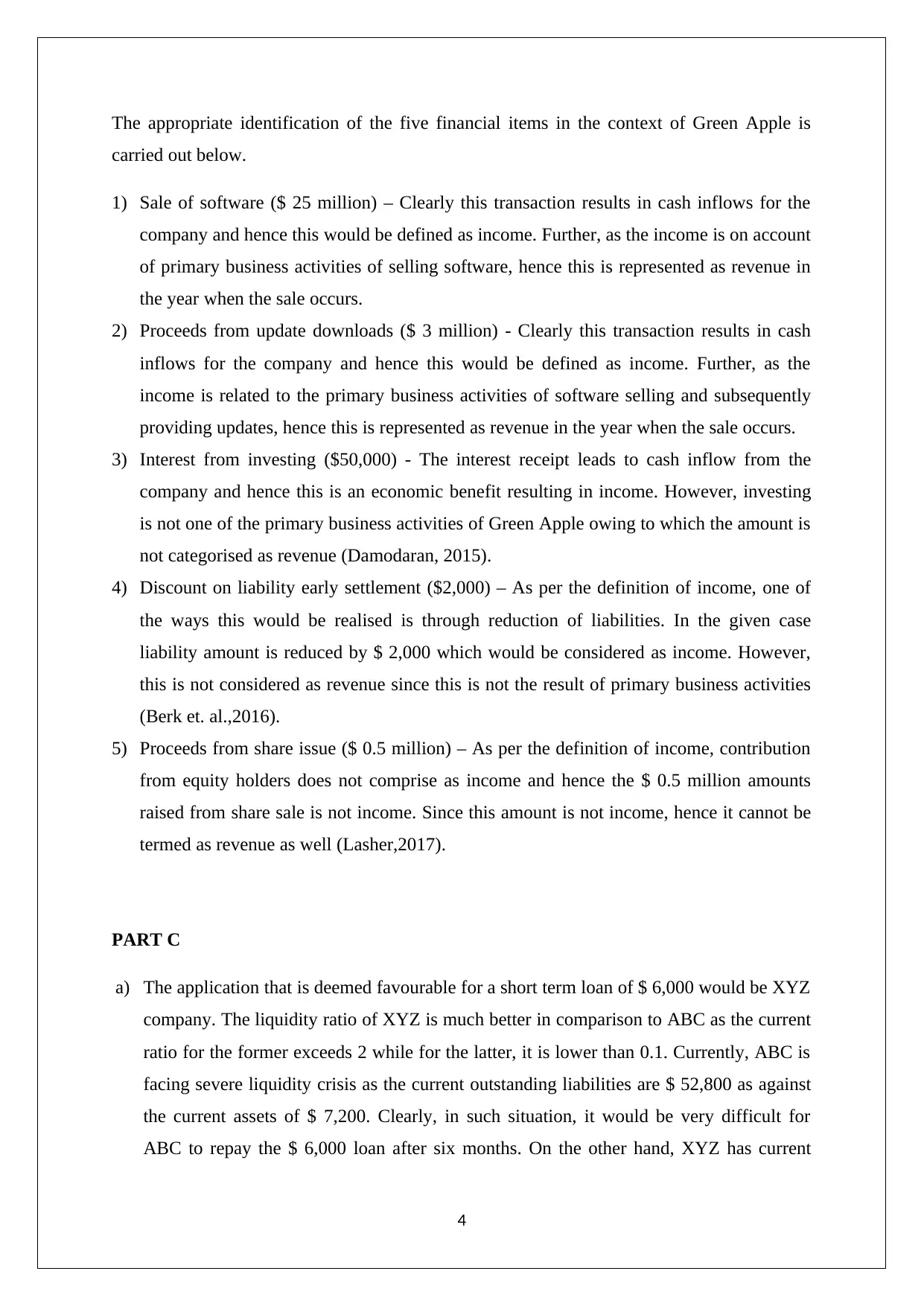
The appropriate identification of the five financial items in the context of Green Apple is
carried out below.
1) Sale of software ($ 25 million) – Clearly this transaction results in cash inflows for the
company and hence this would be defined as income. Further, as the income is on account
of primary business activities of selling software, hence this is represented as revenue in
the year when the sale occurs.
2) Proceeds from update downloads ($ 3 million) - Clearly this transaction results in cash
inflows for the company and hence this would be defined as income. Further, as the
income is related to the primary business activities of software selling and subsequently
providing updates, hence this is represented as revenue in the year when the sale occurs.
3) Interest from investing ($50,000) - The interest receipt leads to cash inflow from the
company and hence this is an economic benefit resulting in income. However, investing
is not one of the primary business activities of Green Apple owing to which the amount is
not categorised as revenue (Damodaran, 2015).
4) Discount on liability early settlement ($2,000) – As per the definition of income, one of
the ways this would be realised is through reduction of liabilities. In the given case
liability amount is reduced by $ 2,000 which would be considered as income. However,
this is not considered as revenue since this is not the result of primary business activities
(Berk et. al.,2016).
5) Proceeds from share issue ($ 0.5 million) – As per the definition of income, contribution
from equity holders does not comprise as income and hence the $ 0.5 million amounts
raised from share sale is not income. Since this amount is not income, hence it cannot be
termed as revenue as well (Lasher,2017).
PART C
a) The application that is deemed favourable for a short term loan of $ 6,000 would be XYZ
company. The liquidity ratio of XYZ is much better in comparison to ABC as the current
ratio for the former exceeds 2 while for the latter, it is lower than 0.1. Currently, ABC is
facing severe liquidity crisis as the current outstanding liabilities are $ 52,800 as against
the current assets of $ 7,200. Clearly, in such situation, it would be very difficult for
ABC to repay the $ 6,000 loan after six months. On the other hand, XYZ has current
4
carried out below.
1) Sale of software ($ 25 million) – Clearly this transaction results in cash inflows for the
company and hence this would be defined as income. Further, as the income is on account
of primary business activities of selling software, hence this is represented as revenue in
the year when the sale occurs.
2) Proceeds from update downloads ($ 3 million) - Clearly this transaction results in cash
inflows for the company and hence this would be defined as income. Further, as the
income is related to the primary business activities of software selling and subsequently
providing updates, hence this is represented as revenue in the year when the sale occurs.
3) Interest from investing ($50,000) - The interest receipt leads to cash inflow from the
company and hence this is an economic benefit resulting in income. However, investing
is not one of the primary business activities of Green Apple owing to which the amount is
not categorised as revenue (Damodaran, 2015).
4) Discount on liability early settlement ($2,000) – As per the definition of income, one of
the ways this would be realised is through reduction of liabilities. In the given case
liability amount is reduced by $ 2,000 which would be considered as income. However,
this is not considered as revenue since this is not the result of primary business activities
(Berk et. al.,2016).
5) Proceeds from share issue ($ 0.5 million) – As per the definition of income, contribution
from equity holders does not comprise as income and hence the $ 0.5 million amounts
raised from share sale is not income. Since this amount is not income, hence it cannot be
termed as revenue as well (Lasher,2017).
PART C
a) The application that is deemed favourable for a short term loan of $ 6,000 would be XYZ
company. The liquidity ratio of XYZ is much better in comparison to ABC as the current
ratio for the former exceeds 2 while for the latter, it is lower than 0.1. Currently, ABC is
facing severe liquidity crisis as the current outstanding liabilities are $ 52,800 as against
the current assets of $ 7,200. Clearly, in such situation, it would be very difficult for
ABC to repay the $ 6,000 loan after six months. On the other hand, XYZ has current
4
Paraphrase This Document
Need a fresh take? Get an instant paraphrase of this document with our AI Paraphraser
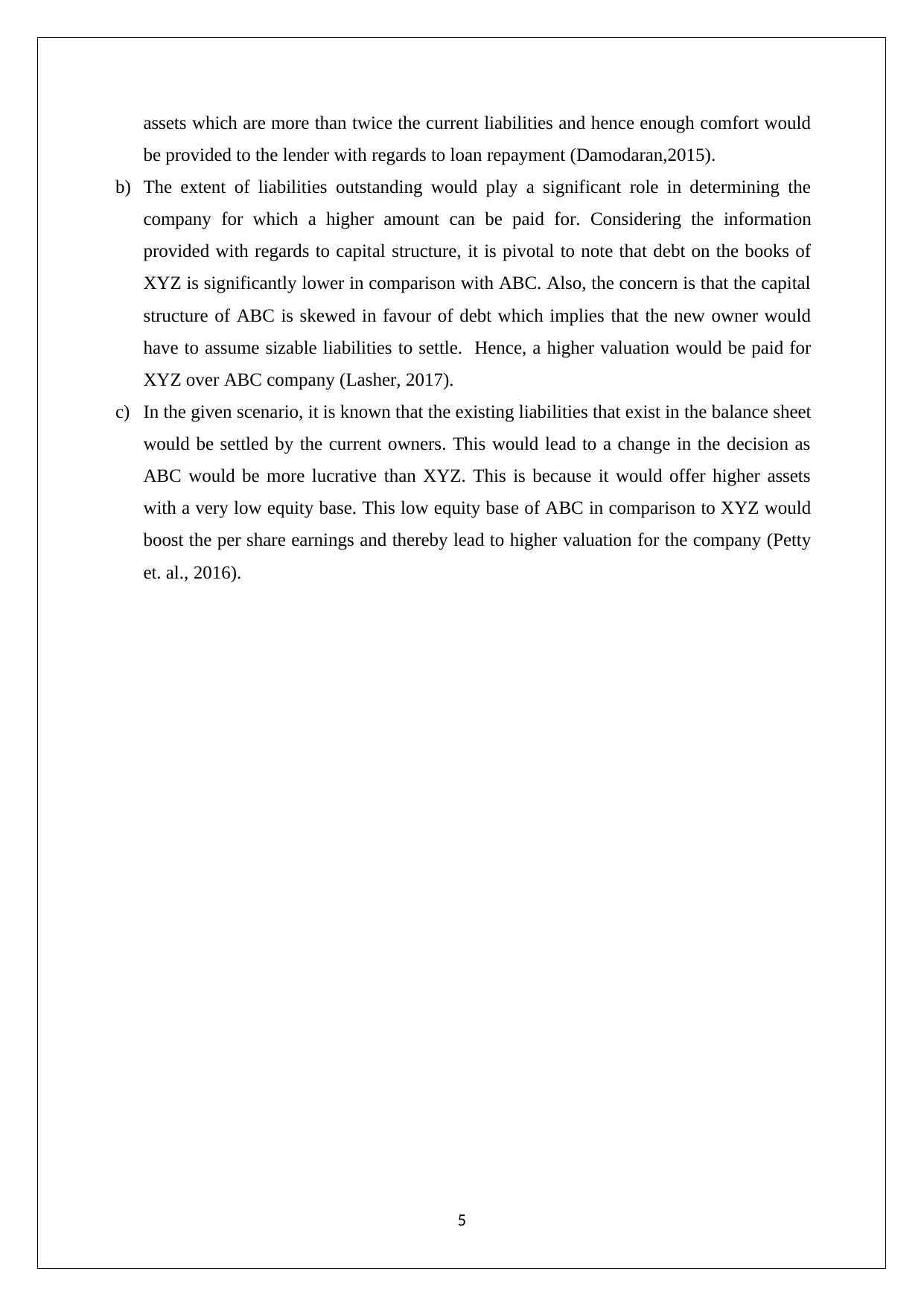
assets which are more than twice the current liabilities and hence enough comfort would
be provided to the lender with regards to loan repayment (Damodaran,2015).
b) The extent of liabilities outstanding would play a significant role in determining the
company for which a higher amount can be paid for. Considering the information
provided with regards to capital structure, it is pivotal to note that debt on the books of
XYZ is significantly lower in comparison with ABC. Also, the concern is that the capital
structure of ABC is skewed in favour of debt which implies that the new owner would
have to assume sizable liabilities to settle. Hence, a higher valuation would be paid for
XYZ over ABC company (Lasher, 2017).
c) In the given scenario, it is known that the existing liabilities that exist in the balance sheet
would be settled by the current owners. This would lead to a change in the decision as
ABC would be more lucrative than XYZ. This is because it would offer higher assets
with a very low equity base. This low equity base of ABC in comparison to XYZ would
boost the per share earnings and thereby lead to higher valuation for the company (Petty
et. al., 2016).
5
be provided to the lender with regards to loan repayment (Damodaran,2015).
b) The extent of liabilities outstanding would play a significant role in determining the
company for which a higher amount can be paid for. Considering the information
provided with regards to capital structure, it is pivotal to note that debt on the books of
XYZ is significantly lower in comparison with ABC. Also, the concern is that the capital
structure of ABC is skewed in favour of debt which implies that the new owner would
have to assume sizable liabilities to settle. Hence, a higher valuation would be paid for
XYZ over ABC company (Lasher, 2017).
c) In the given scenario, it is known that the existing liabilities that exist in the balance sheet
would be settled by the current owners. This would lead to a change in the decision as
ABC would be more lucrative than XYZ. This is because it would offer higher assets
with a very low equity base. This low equity base of ABC in comparison to XYZ would
boost the per share earnings and thereby lead to higher valuation for the company (Petty
et. al., 2016).
5
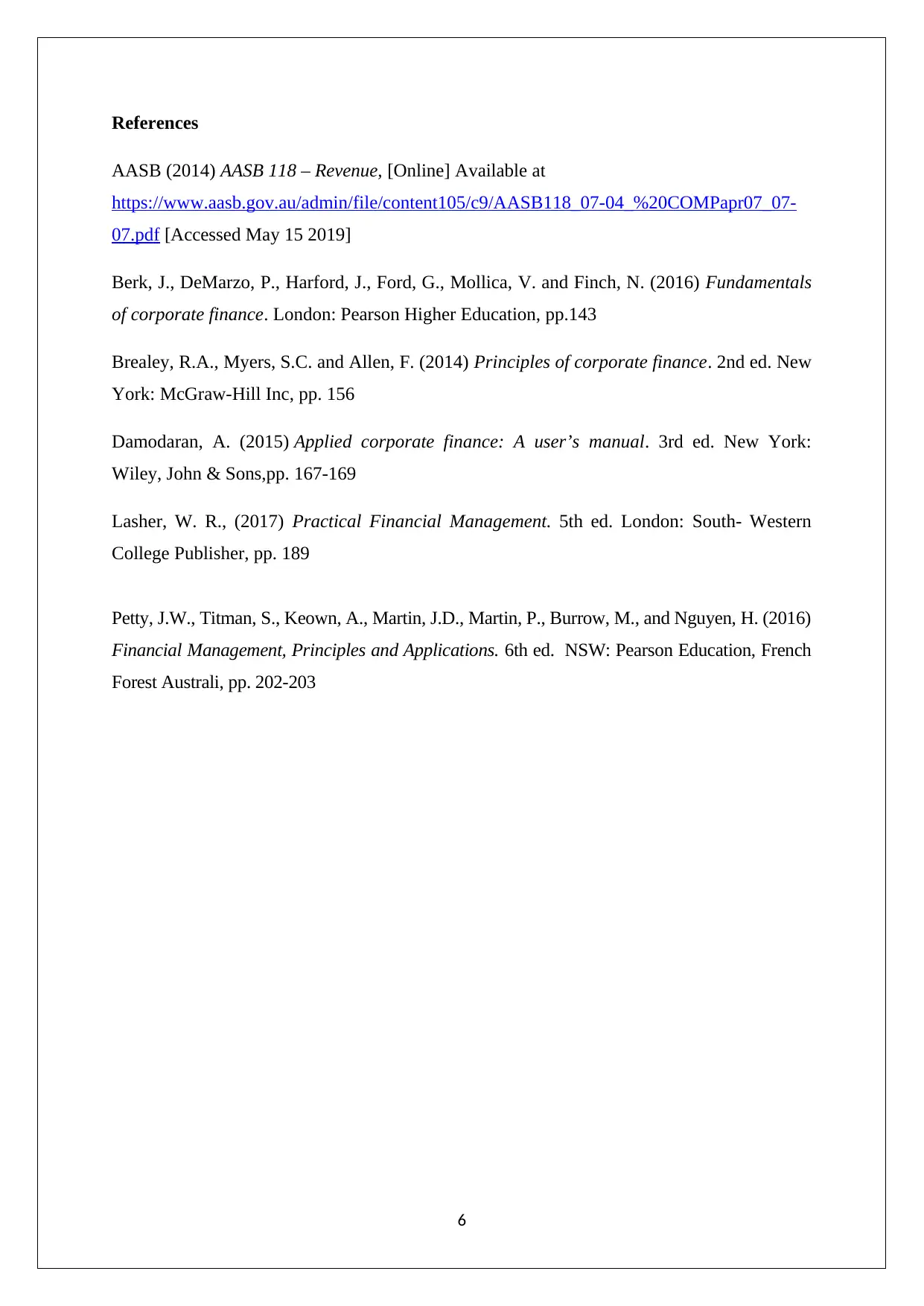
References
AASB (2014) AASB 118 – Revenue, [Online] Available at
https://www.aasb.gov.au/admin/file/content105/c9/AASB118_07-04_%20COMPapr07_07-
07.pdf [Accessed May 15 2019]
Berk, J., DeMarzo, P., Harford, J., Ford, G., Mollica, V. and Finch, N. (2016) Fundamentals
of corporate finance. London: Pearson Higher Education, pp.143
Brealey, R.A., Myers, S.C. and Allen, F. (2014) Principles of corporate finance. 2nd ed. New
York: McGraw-Hill Inc, pp. 156
Damodaran, A. (2015) Applied corporate finance: A user’s manual. 3rd ed. New York:
Wiley, John & Sons,pp. 167-169
Lasher, W. R., (2017) Practical Financial Management. 5th ed. London: South- Western
College Publisher, pp. 189
Petty, J.W., Titman, S., Keown, A., Martin, J.D., Martin, P., Burrow, M., and Nguyen, H. (2016)
Financial Management, Principles and Applications. 6th ed. NSW: Pearson Education, French
Forest Australi, pp. 202-203
6
AASB (2014) AASB 118 – Revenue, [Online] Available at
https://www.aasb.gov.au/admin/file/content105/c9/AASB118_07-04_%20COMPapr07_07-
07.pdf [Accessed May 15 2019]
Berk, J., DeMarzo, P., Harford, J., Ford, G., Mollica, V. and Finch, N. (2016) Fundamentals
of corporate finance. London: Pearson Higher Education, pp.143
Brealey, R.A., Myers, S.C. and Allen, F. (2014) Principles of corporate finance. 2nd ed. New
York: McGraw-Hill Inc, pp. 156
Damodaran, A. (2015) Applied corporate finance: A user’s manual. 3rd ed. New York:
Wiley, John & Sons,pp. 167-169
Lasher, W. R., (2017) Practical Financial Management. 5th ed. London: South- Western
College Publisher, pp. 189
Petty, J.W., Titman, S., Keown, A., Martin, J.D., Martin, P., Burrow, M., and Nguyen, H. (2016)
Financial Management, Principles and Applications. 6th ed. NSW: Pearson Education, French
Forest Australi, pp. 202-203
6
⊘ This is a preview!⊘
Do you want full access?
Subscribe today to unlock all pages.

Trusted by 1+ million students worldwide
1 out of 6
Related Documents
Your All-in-One AI-Powered Toolkit for Academic Success.
+13062052269
info@desklib.com
Available 24*7 on WhatsApp / Email
![[object Object]](/_next/static/media/star-bottom.7253800d.svg)
Unlock your academic potential
Copyright © 2020–2025 A2Z Services. All Rights Reserved. Developed and managed by ZUCOL.





